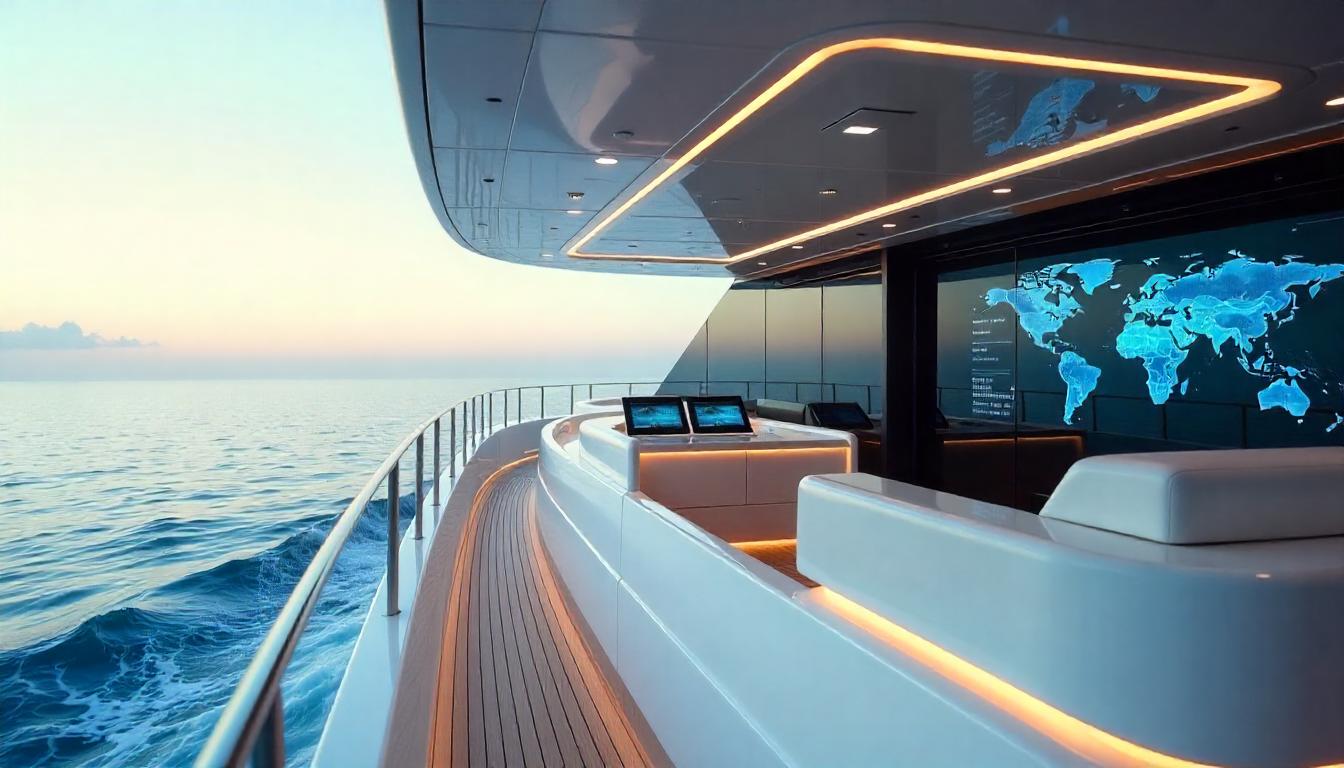The shimmering horizon has long been a symbol of freedom and adventure, but the way we traverse it is on the cusp of a radical transformation. For centuries, the helm of a vessel has been a human domain, a place of skill, intuition, and command. Today, however, that domain is being re-imagined by artificial intelligence and robotics. The future of autonomous yachts is not a distant science-fiction fantasy; it is a burgeoning reality. This new era of self-navigating vessels promises to redefine everything we know about luxury, safety, and efficiency at sea. For a traveler from a landlocked region like Aktobe, the thought of a vessel navigating the world’s oceans with no one at the helm may seem extraordinary. Nevertheless, this technology is already being meticulously developed and tested, paving the way for a new generation of maritime adventures. This article delves into the technological marvels, profound benefits, complex challenges, and exciting possibilities that define the dawn of the autonomous age on the water.
The Core Technology Behind Self-Navigating Yachts
The journey to autonomy is a complex orchestration of cutting-edge hardware and sophisticated software. At its heart, a self-navigating yacht is a fusion of AI, sensors, and communication systems.
AI-Powered Navigation and Decision Making
At the forefront of this revolution is artificial intelligence. An AI navigation system constantly analyzes vast amounts of data to plot the safest and most efficient course. It processes real-time information from radar, sonar, cameras, and GPS. Consequently, the system can detect other vessels, obstacles, weather patterns, and navigational hazards in an instant. The AI makes predictive judgments, calculating optimal speed, heading, and route adjustments to avoid collisions and conserve energy. Furthermore, these systems learn from every voyage, continually refining their algorithms to improve performance. This cognitive ability allows the yacht to make decisions far faster than a human crew could. It also helps to prevent human error, which remains a primary cause of marine accidents.
Advanced Sensor Fusion and Environmental Awareness
The “eyes and ears” of an autonomous yacht are a network of integrated sensors. Lidar provides a high-resolution 3D map of the surroundings, while thermal cameras can detect heat signatures from other vessels or objects, even in low visibility. Sonar maps the seafloor, helping the yacht to avoid underwater obstacles or shallow areas. All this data is seamlessly integrated through a process called “sensor fusion,” which creates a comprehensive and highly accurate picture of the yacht’s environment. This constant awareness is what allows an uncrewed yacht to operate safely and effectively. It provides a level of situational awareness that even the most experienced captain cannot match, especially in challenging conditions like fog or heavy rain.
The Benefits and Promises of Autonomy
The development of autonomous yachts is driven by compelling advantages that promise to transform the industry.
Enhanced Safety and Precision
Safety is the paramount benefit of autonomous technology. A machine does not get tired, distracted, or complacent. It continuously monitors every system and environmental factor. An AI can detect and respond to potential dangers faster and more consistently than a human. The system can even perform complex evasive maneuvers with precision. Consequently, it can significantly reduce the risk of collisions or groundings. Furthermore, onboard monitoring systems can predict and prevent mechanical failures, providing a new layer of security for both the vessel and its passengers.
Unprecedented Efficiency and Sustainability
Autonomous systems are fundamentally programmed for optimization. They calculate the most fuel-efficient routes, taking into account currents, tides, and weather. As a result, they can significantly reduce fuel consumption and carbon emissions. This is a massive step toward greater sustainability in the marine industry. Additionally, these vessels can travel at optimal speeds and in more direct lines, reducing journey times. The savings in fuel and operational costs can also be substantial. This makes autonomous yachts a financially attractive option for owners in the long run.
Redefining Luxury and Privacy
The most appealing aspect for many owners is the new level of luxury and privacy. Imagine having a yacht that can sail to a remote anchorage, tender at your command, and perform all logistical tasks without a crew onboard. This provides complete solitude and discretion. The space once occupied by crew cabins can be repurposed into expanded guest living areas, gyms, or spas. The vessel becomes a truly private sanctuary. This redefinition of luxury is a cornerstone of the future of autonomous yachts. It offers a new level of freedom and personal space that is unprecedented in traditional yachting.
Navigating the Challenges and Hurdles of Uncrewed Yachts
Despite the compelling benefits, the path to widespread adoption is not without its obstacles.
Regulatory and Legal Frameworks
The biggest hurdle is the absence of a clear regulatory framework. International maritime law, which dates back to a time of human-crewed vessels, is still catching up. Who is liable in the event of an accident? What are the requirements for a vessel to operate without a human on board? A global standard for certification and operation is necessary before these vessels can travel freely between countries. International bodies and national governments are now working to establish these rules. However, the process is complex and will take time.
Cybersecurity and Data Integrity
An autonomous yacht is a sophisticated network of connected systems. This connectivity, however, creates new vulnerabilities. A vessel’s navigation or control systems could be a target for malicious actors. Protecting the yacht from cyberattacks is therefore a top priority. Robust encryption and cybersecurity protocols are crucial to ensure the safety and reliability of the vessel. The integrity of the data from its sensors must be absolute. The industry is investing heavily in securing these systems.
Public Perception and Trust
Public acceptance is a significant factor. The idea of a large, uncrewed vessel navigating a busy waterway can be unsettling to some. Building trust in the technology will require extensive testing, flawless safety records, and transparent communication. People need to feel confident that the AI is more reliable than a human captain. Gaining this trust is a long-term endeavor. As the technology proves itself, however, public perception will gradually shift.
A New Era of Yacht Ownership and Chartering
The transition to full autonomy is likely to be a phased one, starting with increasing levels of automation.
The Transition to Partially and Fully Autonomous Vessels
In the short term, we will see more vessels with assisted navigation systems. These systems act as a second pair of eyes for the crew, providing warnings and suggestions. Following this, we can expect partially autonomous vessels. These yachts will be able to navigate on their own, but a human will be required to be onboard to take control if necessary. The ultimate goal is the fully uncrewed vessel, which operates with no one on board. This gradual transition allows for the technology to mature and for regulations to evolve in parallel.
Crew Roles in an Autonomous Future
The rise of autonomy does not necessarily mean the end of the crew. Instead, their roles will evolve. Crew members may transition from helmsmen to systems managers, monitoring the yacht’s performance from a remote command center. Onboard, crew can focus on providing bespoke hospitality and exceptional service, as the yacht handles the complex tasks of navigation and maintenance. For charterers, this means a new level of service and a more focused luxury experience.

The Outlook and Roadmap to Full Autonomy
The roadmap for the future of autonomous yachts is a clear progression of technological milestones.
Short-Term: Assisted Navigation
Today, assisted navigation is already a reality. Many modern yachts feature advanced docking assistance, autopilot systems, and anti-collision warnings. These technologies reduce the workload on the crew and increase safety. They are the building blocks of future autonomy.
Mid-Term: Remote-Controlled and Partially Autonomous
In the next decade, we will see a surge in remotely controlled yachts. A captain could command a vessel from a command center onshore, potentially from anywhere in the world. Furthermore, partially autonomous yachts will become more common. A limited crew could be onboard to manage guest services while the AI handles the navigation. This will open up new cruising grounds and charter opportunities.
Long-Term: Fully Uncrewed Voyages
The long-term vision is a fleet of fully uncrewed yachts. These vessels could embark on long-distance, transoceanic voyages with no one onboard. An owner could simply board at their destination. This would revolutionize delivery voyages and allow for truly global cruising. The journey to this final stage will be methodical, driven by safety, reliability, and regulatory approval.
Ultimately, the future of autonomous yachts is a journey of innovation that promises to make marine travel safer, more efficient, and more luxurious than ever before. While the technical and legal challenges are considerable, the industry is moving steadily towards a world where a yacht’s intelligence is as impressive as its beauty.

 The Future of Autonomous Yachts">
The Future of Autonomous Yachts">
